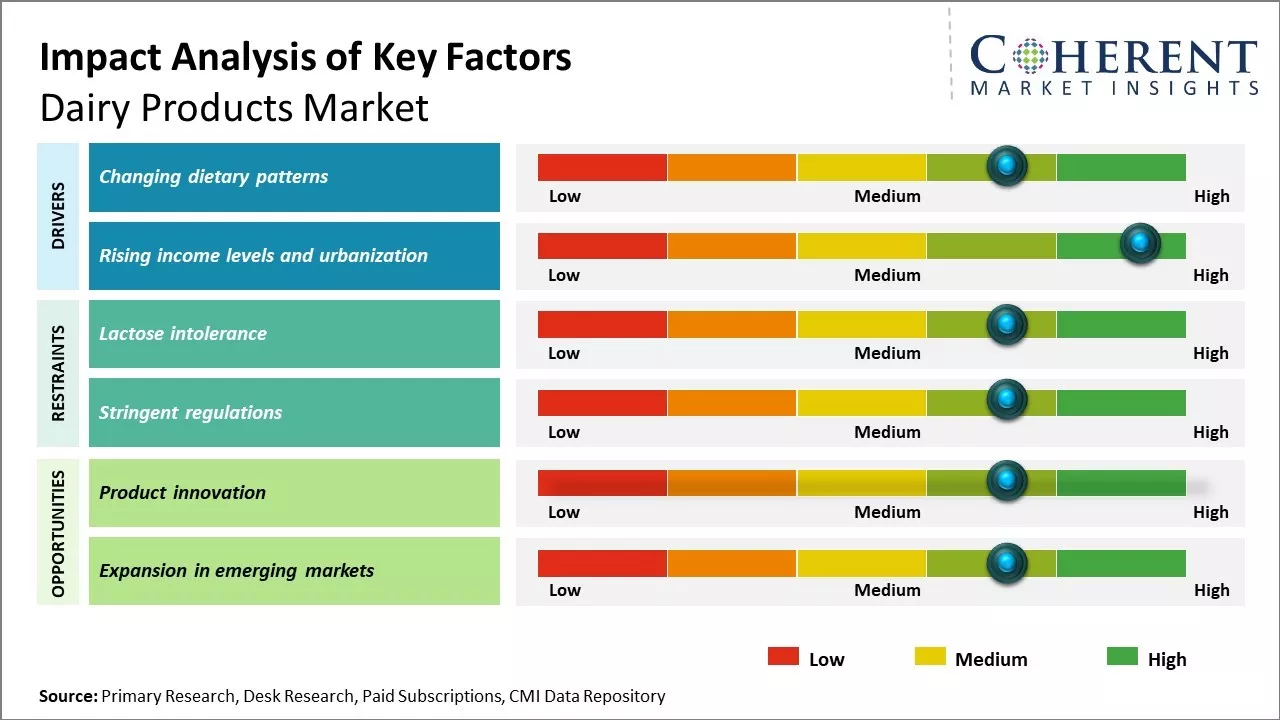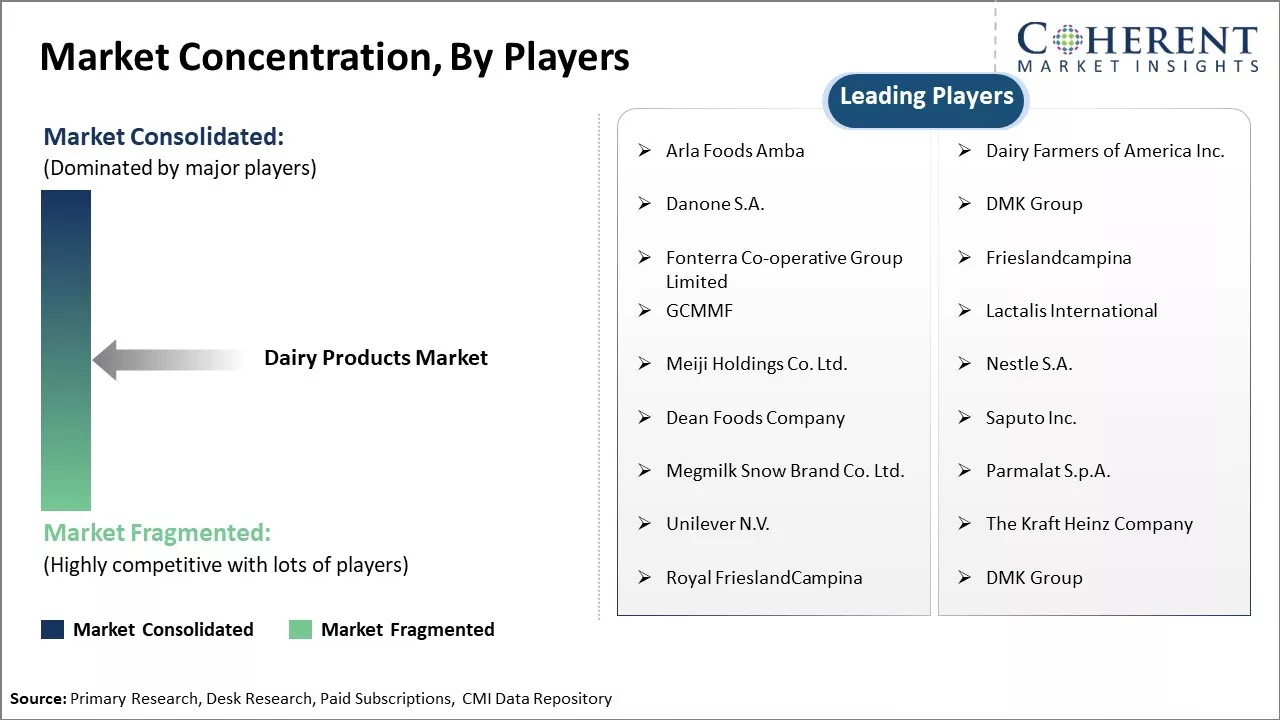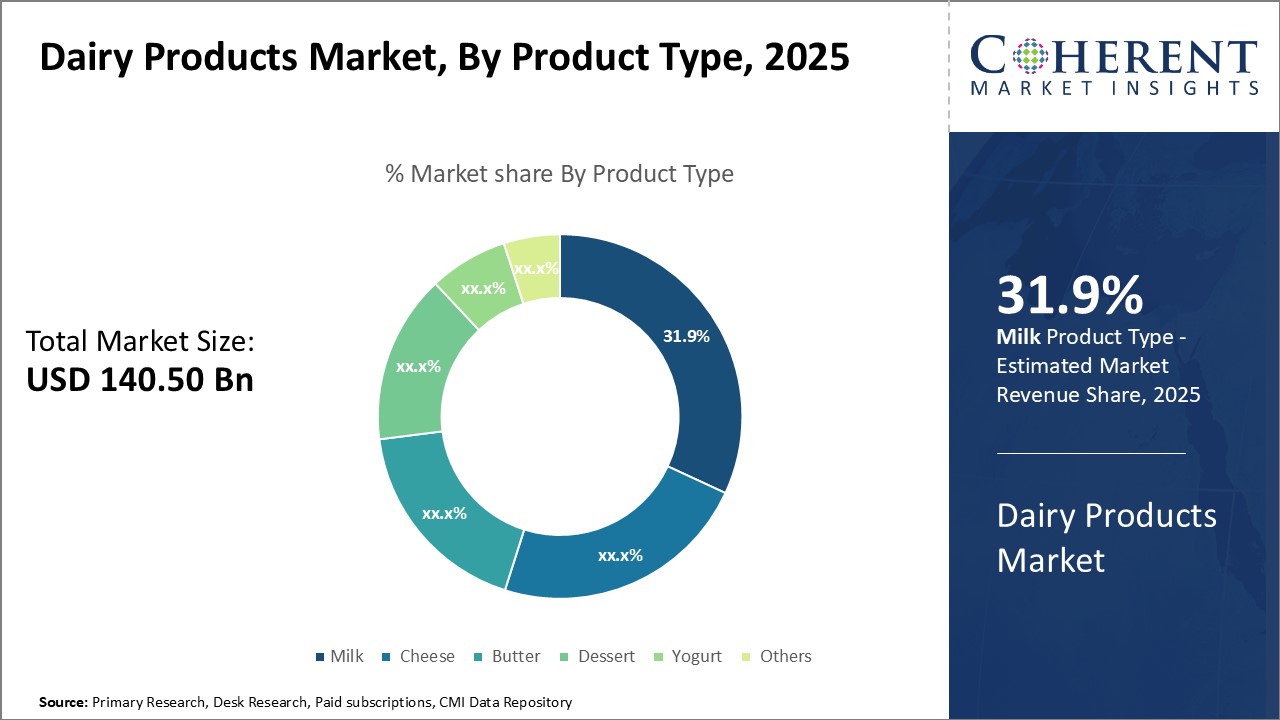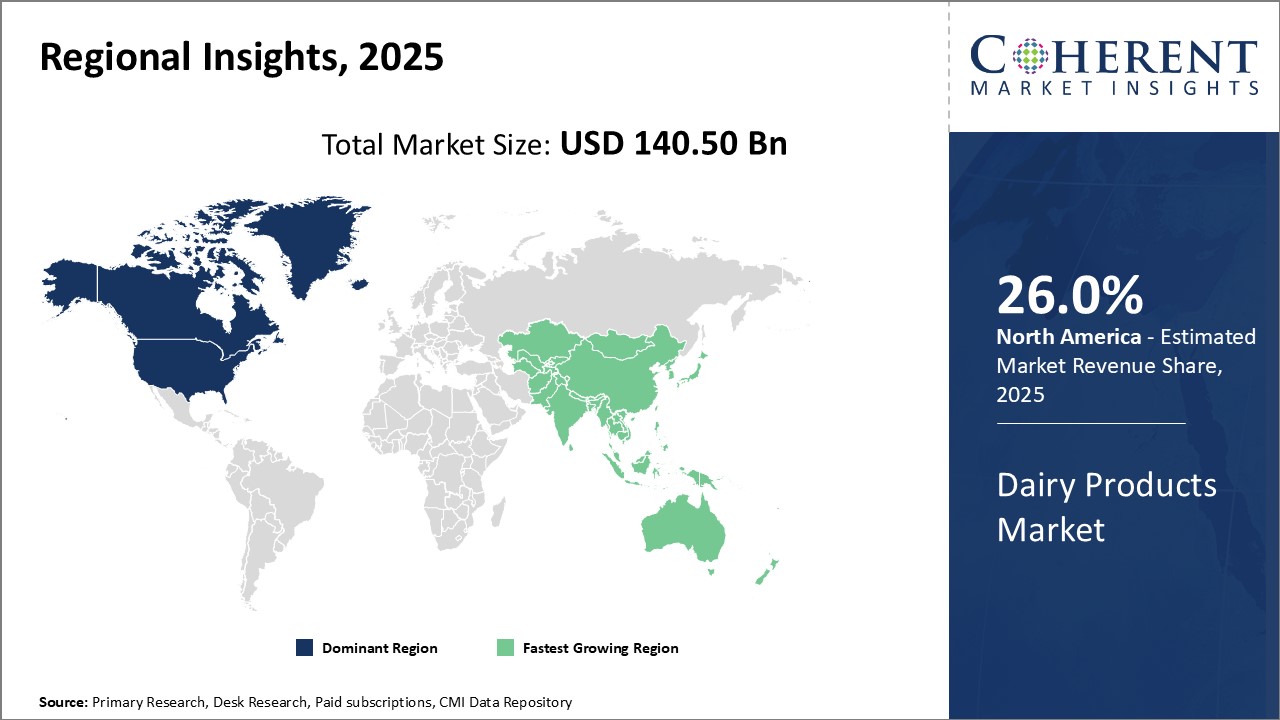The Dairy Products Market is estimated to be valued at USD 140.50 Bn in 2025 and is expected to reach USD 247.26 Bn by 2032, exhibiting a compound annual growth rate (CAGR) of 8.4% from 2025 to 2032.

Discover market dynamics shaping the industry: Request sample copy
Factors such as rising health consciousness, changing consumer preferences, and growing demand for nutritious dairy-based products will drive the market. Increasing awareness about the health benefits of dairy products along with growing affordability is propelling the sales of value-added dairy products such as flavored milk, yogurt, cheese, butter, and cream globally. Rising living standards coupled with growing population will also augment the demand for dairy products. Manufacturers are launching innovative products to cater to dynamic consumer tastes, adopting advanced processing technologies, and leveraging e-commerce channels to boost market presence which will further aid in the market expansion.
Changing dietary patterns
One of the key drivers of the global dairy products market has been the steady shift in dietary patterns and food consumption habits across various regions. While dairy consumption has traditionally been a staple in developed Western markets, consumption in developing Asian and Middle-Eastern countries is on the rise due to increasing health awareness, disposable incomes, and hectic urban lifestyles.
There is a growing preference toward packaged dairy products such as flavored milk, yogurt, and dairy-based beverages that provide convenience without compromising on nutrition. As more people lead fast-paced lives working long hours, there is demand for dairy options that can be quickly consumed on-the-go. Living independently away from families also drives young consumers to rely more on processed packaged foods including dairy items that can be easily stored and cooked with. Rising health consciousness has been another important factor influencing dairy consumption globally. Studies proving the various benefits of dairy in maintaining strong bones, muscle development and weight management have encouraged many populations to incorporate milk, cheese and yogurt into their diets. In Asian nations where dairy was not a traditional part of cuisine, such health education campaigns by governments and industry bodies have increased awareness about dairy nutrients. This has benefitted yogurt and probiotic milk producers the most.

Get actionable strategies to beat competition: Request sample copy
Rising income levels and urbanization
Dairy consumption patterns are also evolving owing to rapid economic development and urbanization in emerging markets. Rising disposable incomes allow populations to spend more on high quality nutritious food items deemed essential for a balanced diet or those perceived as luxuries in the past.
In countries like China, India, Brazil, and across Southeast Asia, cities are swelling as rural migrants seek better job prospects and living standards. Living in towns and metropolitan areas exposes people to new trends, globalization of tastes and widespread availability of supermarkets and modern retail offering packaged consumer goods. Higher salaries mean enhanced spending power to purchase dairy items consumed by urban elite communities, seen as aspirational lifestyle products. Rising middle-classes now form the bedrock of dairy product sales as branded dairy companies target this socio-economic group with premium yet reasonably priced new product lines customized to regional preferences.
Key Takeaways from Analyst:
The dairy products market is experiencing steady growth driven by increasing consumption of milk, yogurt, cheese, and other products in emerging economies. Rising disposable incomes coupled with growing health consciousness among consumers is fueling the demand for dairy based snacks and beverages. Lactose free and high protein products are gaining popularity among people with lactose intolerance or diabetes.
Volatile raw milk prices continue to pose challenges for dairy processors due to variability in milk production. Strict environment regulations and competition from plant-based dairy alternatives also act as a restraint. Opportunities lie in product expansion targeting specific demographic segments like kids, millennials and aging population.
Among regions, North America dominates the global dairy products market benefiting from rising living standards and westernization of diets. Countries like U.S. and Canada offer immense headroom for growth.
Market Challenge: Lactose intolerance
Lactose intolerance has been one of the key barriers in the growth of the dairy products market worldwide. There has been a steady rise in the population suffering from lactose intolerance in the recent past across regions. As per the National Institute of Health, it is estimated that around 65% of the global population has a reduced ability to digest lactose after infancy. This number is as high as 90% among certain communities and ethnic backgrounds like Asia, Africa, and South America. The inability to digest lactose sugar presents itself in the form of various gastrointestinal issues like abdominal pain, bloating, cramps and diarrhea for those consuming dairy products. This leads to a majority of the lactose intolerant population limiting or avoiding dairy altogether from their diet. As dairy remains one of the primary sources of calcium, protein and other nutrients, this poses a significant health challenge for them. Many are forced to look for alternative dairy-free sources of daily nutrition or calcium supplements instead. This self-imposed restriction has negatively impacted the volumes and has stunted the potential reach of the dairy industry.
Market Opportunities: Product innovation
Product innovation provides a significant opportunity for growth in the dairy products market. As consumers are continuously looking for new, nutritious and convenient options, dairy companies need to proactively develop innovative products that meet these evolving needs and tastes. Some areas that allow for innovation include organic products, plant-based alternatives, probiotic offerings, and single-serve on-the-go packaging formats. One example of innovation helping spur market expansion is the rise of oat milk based products. According to data from the United Nations Food and Agriculture Organization, global oat milk production increased by over 30% between 2017 and 2020. This points to growing demand from consumers seeking non-dairy milk choices that provide similar nutrition from plant-based sources. Leading dairy brands have responded by launching their own oat milk yogurts, ice creams, and creamers. The exposure from these new product lines is attracting more customers to dairy aisles while keeping existing customers engaged.

Discover high revenue pocket segments and roadmap to it: Request sample copy
Insights by product type : Owing to Ubiquitous Consumption and Nutritional Value, Milk Dominates the Dairy Products Market
Milk has cemented its position as the top product type segment in the dairy products market due to its widespread consumption and nutritional advantages with an estimated 31.9% share in 2025. As a staple ingredient in cooking and an excellent source of calcium, protein and other essential nutrients, milk enjoys near-universal demand across demographics. It caters to the needs of both adults and children as a breakfast staple as well as a versatile cooking ingredient. The nutritional value of milk makes it a preferred choice for consumers of all ages seeking to maintain strong bones and muscles. Educational initiatives by dairy farmers have also highlighted milk's role in promoting overall health and fitness. Its protein content in particular provides satiety and curbs hunger pangs between meals. As more people prioritize fitness and wellness, milk has grown in popularity as a functional beverage choice.
Beyond nutrition, milk is cost-effective compared to alternative sources of protein and calcium. Readily available in supermarkets, general stores and online retail channels nationwide, milk has unmatched penetration given its mass appeal and everyday shelf presence. Dairy farmers too have optimized milk production through advanced cattle breeding and farming techniques to ensure year-round supplies. Manufacturers have furthered milk's versatile uses through value-added products like flavored milk drinks, lactose-free variants and dairy blends. These extensions expand the target audience beyond traditional milk consumers. Demand remains buoyant across urban and rural regions supported by steady household consumption as well as institutional bulk purchases.
Insights by distribution channel : Supermarket/Hypermarket Dominance Stems from Convenience of One-Stop Shopping and Broader Selection
The supermarket/hypermarket segment reigns over other distribution methods in the dairy products market owing to the irresistible attraction of consolidated shopping with an estimated 33.8% share in 2025. These large format stores pull consumers through their doors with a wide assortment of product choices combined with the ease of completing all shopping needs at one location. In particular, supermarket giants set themselves apart through extensive stocks of milk, yogurt, cheese and other perishables sectioned together for effortless selection. Customers appreciate browsing diverse dairy brands and private labels in air-conditioned comfort versus making multiple stops. Supermarkets also maintain consistent supplies through centralized procurement, logistics and shelving programs.
Pricing is another deciding factor as supermarkets leverage bulk purchase volumes to offer competitive rates. loyalty programs and in-store promotions further sweeten deals on dairy essentials. Customers can save on frequency staples while also discovering new products and flavors. The 'big basket' philosophy resonates strongly with time-strapped consumers seeking a quick, fuss-free shopping experience. Families especially regularly source all household needs from supermarkets on their monthly or fortnightly main shop. Store expansions into new neighborhoods expand their reach into untapped consumer clusters as well.

Need a Different Region or Segment? Customize now
North America has established itself as the dominant region in the global dairy products market. With the presence of major players like Dairy Farmers of America, Dean Foods, Leprino Foods, and Schreiber Foods, the North America dairy market accounts for over 26.0% of the global dairy output in 2025. Supported by advanced infrastructure for transportation and cold storage, dairy producers in the U.S. supply both domestic and international markets efficiently. Being located near large consumer bases, North American companies also have logistical advantages over competitors. Moreover, dairy is a strategic sector for the Canadian and Mexican economies. The Free Trade Agreement has further strengthened dairy trade links between the three NAFTA nations.
The Asia Pacific region has emerged as the most dynamic marketplace for dairy products worldwide. Rapid urbanization, rising living standards, and changing dietary habits are fueling strong demand growth in the major Asian countries. China is leading this momentum, where consumption of dairy products has doubled in recent years. Efforts by the Chinese government to boost domestic milk production have seen limited success. As local supply struggles to match booming demand, Asia Pacific nations are increasingly looking outside to fulfill their dairy needs through imports. India is another key opportunity, with dairy being central to both agriculture and nutrition in the country. However, infrastructure bottlenecks and environmental concerns continue to hamper the sector's full potential in Asia.
Dairy Products Market Report Coverage
| Report Coverage | Details | ||
|---|---|---|---|
| Base Year: | 2024 | Market Size in 2025: | USD 140.50 Bn |
| Historical Data for: | 2020 To 2024 | Forecast Period: | 2025 To 2032 |
| Forecast Period 2025 to 2032 CAGR: | 8.4% | 2032 Value Projection: | USD 247.26 Bn |
| Geographies covered: |
|
||
| Segments covered: |
|
||
| Companies covered: |
Arla Foods Amba, Dairy Farmers of America Inc., Danone S.A., DMK Group, Fonterra Co-operative Group Limited, Frieslandcampina, GCMMF, Lactalis International, Meiji Holdings Co. Ltd., Nestle S.A., Dean Foods Company, Saputo Inc., Megmilk Snow Brand Co. Ltd., Parmalat S.p.A., Unilever N.V., The Kraft Heinz Company, Royal FrieslandCampina, andDMK Group |
||
| Growth Drivers: |
|
||
| Restraints & Challenges: |
|
||
Uncover macros and micros vetted on 75+ parameters: Get instant access to report
*Definition: The dairy products market refers to the business of producing and selling milk-based food items globally. It involves the manufacturing, packaging, and distribution of various types of milk such as whole milk, low-fat milk, skim milk, condensed and evaporated milk, and cream. Additional dairy products in this market include butter, cheese, yogurt, ice cream, lactose-reduced milk and plant-based milk alternatives. The dairy products market caters to grocery retailers, food manufacturers, restaurants, educational institutions, and households worldwide. It aims to provide consumers with high-quality, nutritious dairy-based foods and beverages.
Share
Share
About Author
Yash Doshi is a Senior Management Consultant. He has 12+ years of experience in conducting research and handling consulting projects across verticals in APAC, EMEA, and the Americas.
He brings strong acumen in helping chemical companies navigate complex challenges and identify growth opportunities. He has deep expertise across the chemicals value chain, including commodity, specialty and fine chemicals, plastics and polymers, and petrochemicals. Yash is a sought-after speaker at industry conferences and contributes to various publications on topics related commodity, specialty and fine chemicals, plastics and polymers, and petrochemicals.
Missing comfort of reading report in your local language? Find your preferred language :
Transform your Strategy with Exclusive Trending Reports :
Frequently Asked Questions
Joining thousands of companies around the world committed to making the Excellent Business Solutions.
View All Our Clients
US Reciprocal Tax Impact Analysis On Dairy Products Market
Stay updated on tariff changes with expert insights and timely information